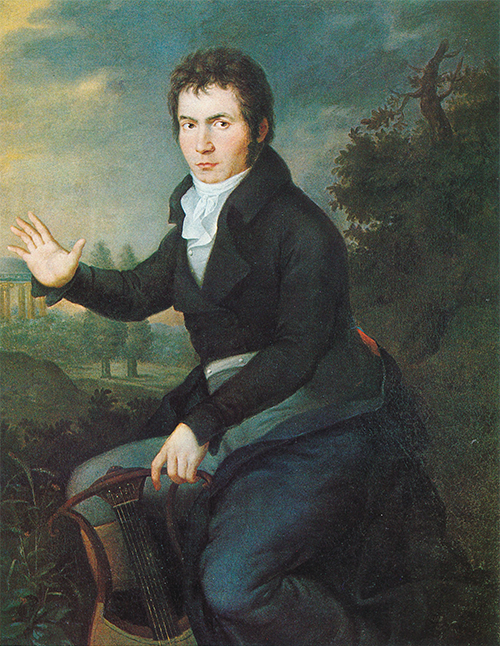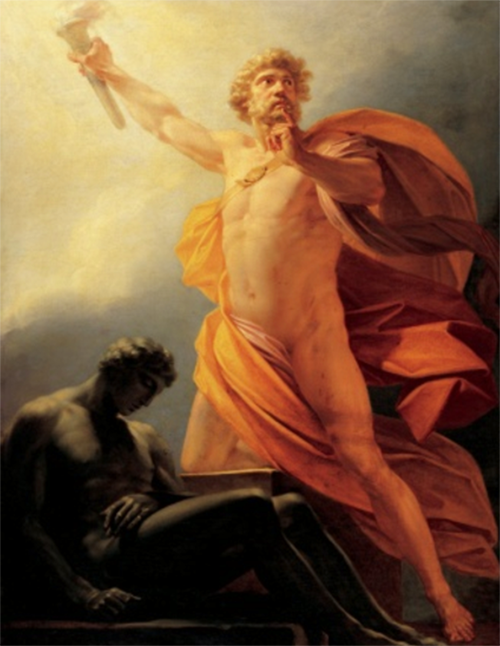As part of the Centennial Season’s celebration, Franz Welser-Möst has created “The Prometheus Festival,” examining Beethoven’s music through the metaphor of Prometheus, a daring Titan who defied Zeus to bestow on humanity the gift of fire. For Beethoven, this represented the beginning of human civilization, the spark of creativity that has powered the imagination of generations, the warmth of justice and goodness, and the fight for individual rights and freedoms.
In support of this project, The Cleveland Orchestra Archives is pleased to offer a series of online essays designed to enrich the concert experience and to provide in-depth historical information for anyone interested in the Orchestra’s performance history and its archival audio recordings of Beethoven repertoire. Essay link below include links to the Orchestra’s rich audio legacy to the Prometheus cycle.
The Cleveland Orchestra gratefully acknowledges generous funding from the National Endowment for the Arts in support of this project.
PRINTED PROGRAM BOOK
To view and read the printed program book for The Prometheus Project concerts (May 10-19, 2018), click or tap here.

PANEL DISCUSSION
On Wednesday, May 9, 2018, an in-depth discussion was presented with Franz Welser-Möst and Mark Evan Bonds in conversation with Francesa Brittan about The Prometheus Project. This discussion was broadcast live and can be viewed here:
ONLINE ESSAYS AND AUDIO LINKS
Beethoven: The Prometheus Connection
“Persevere, do not only practice your art, but endeavor also to fathom its inner meaning; it deserves this effort. For only art and science can raise men to the level of gods.”
— Ludwig van Beethoven in a letter to Emilie M. [surname unknown], 18121
 Portrait of Beethoven (1804/05), by Joseph Willibrord Mähler.
Portrait of Beethoven (1804/05), by Joseph Willibrord Mähler.
In 1812, Ludwig van Beethoven received a letter from a young pianist named Emilie M. Her letter, enclosed with a home-made embroidered pocketbook, expressed her fondness for, and appreciation of, his music. Taking this gesture to heart, Beethoven responded with a heartfelt missive in which he, in a mentor-like way, described his conception of art and humanity. The quote above, taken from the start of the letter’s central paragraph, is remarkable for its concise explication of Beethoven’s Promethean ideas about the power of art to transform humanity and society.
Prometheus was the last of the Titans in Greek mythology. He sided with the younger upstart gods, led by Zeus, in their war against the Titans. After this war, Prometheus showed sympathy with, and loyalty to, another downtrodden group, humanity. To aid them, Prometheus shared the secrets of fire so that they might raise themselves up from the earth like the gods. The myth differs in each telling — some have Prometheus sharing other secrets, such as art or metalworking, and some, that Zeus took away fire from the humans and Prometheus stole it back for humanity — but virtually all agree that it was the fire of Prometheus that illuminated humanity and allowed civilization to develop.
 Prometheus Brings Fire to Mankind (c. 1817), painting by Heinrich Füger.
Prometheus Brings Fire to Mankind (c. 1817), painting by Heinrich Füger.
For Beethoven, the story of Prometheus held an answer to the question of how to reform society and uplift mankind. As Friedrich Schiller, an older contemporary philosopher-poet whom Beethoven read and admired (and would later immortalize in the “Ode to Joy”), argued in On the Aesthetic Education of Man (1794): Political revolution could not bring about a transformation of society but that only aesthetic education, an appreciation of “The Good, The True, and the Beautiful” as found in Art could do so.2 Central to this was the metaphorical figure of Prometheus, an enlightened figure who could guide others by sharing with them the gift of fire. Beethoven saw himself as such a figure, and sought through his music to expose his listeners to higher emotions and higher ideals: freedom, human rights, and an appreciation of the wonder, beauty, and joy of the world.
It is this conception of Beethoven and his music that inspired The Cleveland Orchestra’s Prometheus Festival. Music Director Franz Welser-Möst has described his conception of Beethoven’s music as a “philosophy put into sounds” inextricably entwined with this Promethean ideology. To that end, the core of the festival is a Beethoven cycle: performances of all nine symphonies, as well as four other significant orchestral pieces. Each work has a different connection to Prometheus and a different message for us to consider.
1 As found and discussed in Lewis Lockwood, Beethoven: The Music and the Life (New York: W.W. Norton, 2005), 9.
2 Jan Swafford, Beethoven: Anguish and Triumph: A Biography (New York: Houghton Mifflin Harcourt, 2014), 266.
Alexander Lawler
Alexander Lawler is a Historical Musicology PhD student at Case Western Reserve University. This is his third year working in the Orchestra’s Archives, having previously written “From the Archives” online essays (2015-2016) and designed a photo digitization and metadata project (2016-2017).

Symphony No. 8
The Eighth Symphony generally has been regarded as the slightest of Beethoven’s mature symphonies because of its short length, lighter tone, and frequent return to the musical styles and forms of the eighteenth century.
Read more >

Leonora Overture No. 3
Fidelio (1805), Beethoven’s only opera, is a celebration of freedom. In the opera, Florestan has been imprisoned by the tyrant Don Pizarro.
Read more >

Symphony No. 2
Beethoven first realized he was becoming deaf in the summer of 1798, at age twenty-seven. After an initial episode of total deafness, Beethoven found that his hearing had become filled with an unending “maddening chorus of squealing, buzzing, and humming.”
Read more >

Symphony No. 6
Beethoven’s Pastoral Symphony premiered on the same concert as the Fifth Symphony (December 22, 1808). The two works were quite different: Whereas the Fifth was a difficult journey from darkness to light, the Pastoral was a genial, warm-hearted journey through the countryside.
Read more >

Grosse Fuge
The Grosse Fuge (Great Fugue) is Beethoven’s most complex work. It was originally to be the last movement of his String Quartet No. 13. However, it unluckily proved to be both technically challenging for the performers and bewildering to the audience, and was, instead, turned into its own stand-alone work.
Read more >

Symphony No. 9
Beethoven’s Ninth Symphony stands as the culmination of Beethoven’s twenty-four-year career as a composer of symphonies. The Ninth both sums up Beethoven’s artistic career and, with the choral finale, daringly points the way forward to new conceptions of what a symphony could say and be.
Read more >